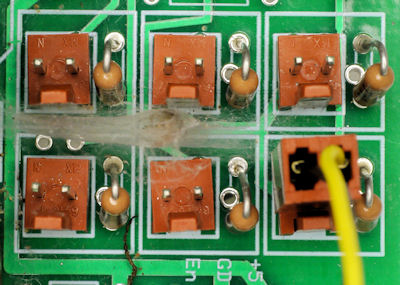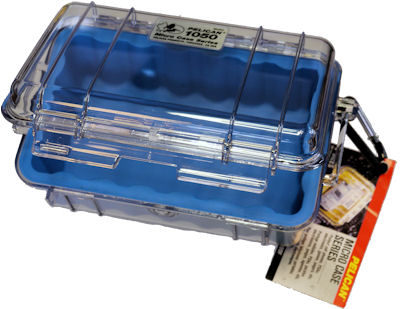The do-it-yourself backyard solar weather station was deployed in the summer when the weather was mild. Until I had time to complete a real project box, I protected the electronic circuit board and battery from the elements with a clear plastic pencil case, #S-2 from SoHo Corporation. (An 840-point solderless breadboard fits perfectly; which is how I store all of my prototypes.)

Temporary weather station box is not sealed, particularly where the wires come out (right).
The pencil box is an inexpensive school supply container intended for indoor use. Not unexpectedly, the hinged shell does not fit perfectly, leaving slight gaps such that the box is not water tight. The dozen wires leading to the external temperature sensors further enlarge the gap.
Because it was a temporary solution, the motherboard is not attached to the bottom of the box ❶. The loose circuit board would be damaged if an animal or the wind knocked the project to the ground.
While retrieving weather data results, I examined the station to determine if any problems had been caused by outdoor conditions. Surprisingly, there was no rain or water damage on the components inside the pencil case. I guess that’s because we didn’t experience any driving rain or monsoons in Chicago.
However, the solar panel was affected by weather because it had been placed outside of the project box to receive solar energy. The clear project box was covered by an aluminum plate to reduce greenhouse heating and to keep the project box from blowing off of the wooden bench.

Solar panel with chemical residue.
When I flipped over the solar panel, I initially believed it had rusted. This seemed odd, since I’m not aware of any iron-based parts.
Upon closer inspection, I noticed that red residue collected around the anode (positive) and white material collected around the cathode (negative). This leads me to believe that droplets of rainwater pooled underneath the solar panel and were separated by electrolysis due to the solar panel’s electricity. I’m not sure of the compounds. Iron oxide? Calcium carbonate or magnesium?
As a kid, I wondered what it would be like if my home consisted entirely of our detached garage. It would be marvelous to have a front door that was an entire wall! But, as I explored the garage, I noticed the large amount of dirt blown in by the wind, as well as numerous insects that found their way inside.

Spider and web on outdoor PCB.
From a bug’s point of view, there is very little difference between a garage and a pencil box. A spider, an earwig, and multiple flying victims had found their way inside the weather station.
With winter closing in, and to avoid dust, insects, and rust, I had to get serious about a project case for the weather station. I purchased a Pelican 1050 Clear Lid Yellow Liner and a Pelican 1050 Clear Lid Blue Liner watertight micro case for around $25 each. Other colors and sizes are available.

Pelican 1050 micro case.
The Pelican cases are really well built. The plastic (clear ABS? polycarbonate?) is twice as thick as most boxes, and has ridges and rounded corners for increased strength. The rubber liner (neoprene) seals the case as well as protects the contents somewhat against physical shock. The hinge pins are stainless steel.
There are other sizes and colors available, besides the yellow and blue 1050 cases. For example, the 1050 case is 16 cm × 9.3 cm × 7 cm, which isn’t as wide as the pencil cases. If you want to fit an 840-point solderless breadboard, you'll need to step up to the 1060 case, which is 20.9 cm × 10.8 cm × 5.7 cm.
There are two features of the Pelican cases that you won’t likely need. First, there is an automatic pressure equalization valve (so I guess the case won’t explode if your battery pack outgases) on the front. This valve is probably why the case is listed as “water resistant” rather than “waterproof”. Second, there is an aluminum carabineer marked “Not for climbing”, which you can use for a keychain or for securing the box to a bench so that thieving raccoons won’t steal it.
One of the problems that I faced with the weather station is the sensor wiring coming out of the box. On the next page, I demonstrate both a lame and a cool way of dealing with it.